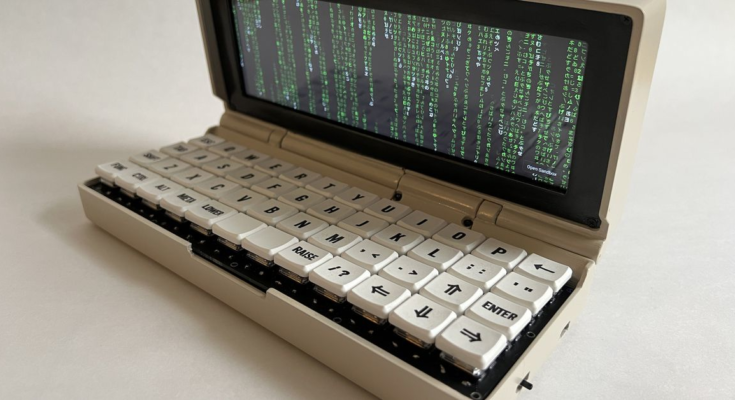There aren’t a lot of ultra-portable handheld PCs anymore, outside of the GDP pocket and its gaming-focused successors. With tablets, smartphones, and even handhelds like the Steam Deck diluting the marketable needs of owning a laptop, there isn’t much space for mini laptops beyond the simple joy of owning a fun-sized version of a traditional computer.
But that’s not stopping DIY-er Penk Chen from building their own handheld PC called the Penkesu — a retro-futuristic ultraportable laptop with a mechanical keyboard. It could very well have existed as a working sci-fi movie prop in the ’90s or an R&B video plot device in 2002.
The case for the Penkesu is built using 3D printed parts paired with hinges designed for the Game Boy Advance SP. The clamshell lid is fitted with a wide 400 x 1,280 7.9-inch capacitive touch screen, wired through the hinge with a ribbon cable carrying the HDMI signal to a Raspberry Pi Zero 2 W at the base.
Then a USB interface with charging, plus a Li-ion battery round off the main computer components, following Chen’s goal to use a minimal amount of electronics. All that’s left for the Penkesu is the keyboard, which consists of an Arduino controller with low-profile Kailh Choc V1 switches, low profiles keycaps, and the rest of the electronics.
:no_upscale()/cdn.vox-cdn.com/uploads/chorus_asset/file/23241795/penkesu_1.computer_assembly_wiring.jpg)
The result is a swanky handheld computer that kind of reminds me of the Raspberry Pi 400 compact keyboard that houses an ARM-powered computer — but with a screen.
This isn’t the first retro-tastic Raspberry Pi laptop we’ve seen, as there was also the apocalypse surviving Raspberry Pi cyberdeck computer. Like the Penkesu, it also has a mechanical keyboard. But instead of a compact design, the cyberdeck’s components are wrapped in a rugged water-proof pelican camera case.
Small laptop designs have gone through phases; at various points, manufacturers raced to build compact and affordable internet-focused netbooks or joined Intel’s war on the MacBook Air with Ultrabooks. But handheld PCs like the super desirable clutch-style Sony VAIO P could never quite catch on. In the case of the VAIO P, this was because it was not very usable due to the slow Intel Atom processor, odd 8-inch 1600 x 786 resolution screen, and a nearly $900 price tag.
:no_upscale()/cdn.vox-cdn.com/uploads/chorus_asset/file/6072189/16_VGN-P70H.1391682298.0.jpg)
But if you loved the form factor of the VIAO P and have a use case for a Raspberry Pi, then maybe this cool retro handheld is something for you. If you can’t think of a reason to build one, just remember it could be the perfect computer for hackers.
If you’re thinking of taking on the project, Penk Chen has posted all the info you need on GitHub, including the 3D printable STL files. And yes, putting in a Matrix wallpaper will actually be tasteful on this device.



